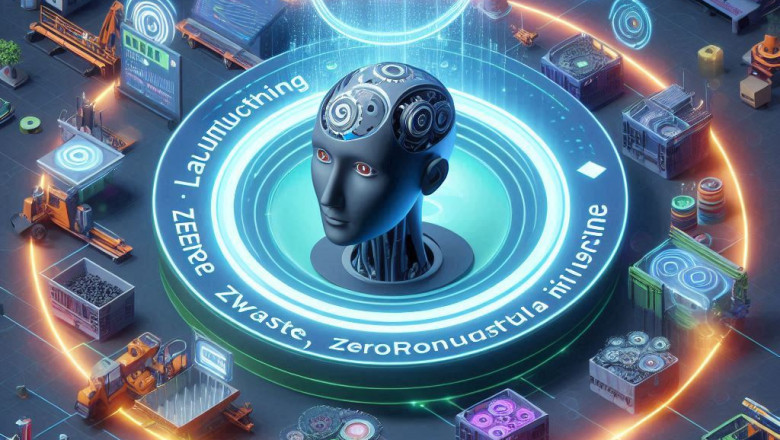views
In an era where sustainability and efficiency dominate global conversations, the manufacturing sector faces a dual challenge: minimizing waste while maximizing productivity. Enter the fusion of circular economy principles and artificial intelligence (AI)—a game-changing synergy that’s redefining how industries operate. From AI-powered waste sorting systems that boost recycling rates to zero-defect production lines that eliminate inefficiencies, this blog explores how cutting-edge technology is paving the way for a greener, smarter industrial revolution.
The Circular Economy Imperative
The linear "take-make-dispose" model is no longer viable. With landfills overflowing and natural resources depleting, the circular economy—a system designed to reuse, repair, and recycle materials—has emerged as the gold standard for sustainable manufacturing. Central to this model is effective waste sorting, which ensures materials re-enter production cycles rather than end up as pollution.
Traditional waste sorting, however, is riddled with challenges: human error, slow processing, and contamination of recyclables. This is where AI steps in, transforming waste management from a cost center into a value-generating pillar of the circular economy.
AI-Driven Waste Sorting: Precision Meets Sustainability
Modern AI-powered waste sorting systems use machine learning algorithms, computer vision, and robotics to identify, classify, and segregate materials with unmatched accuracy. Here’s how they work:
- Smart Sensors and Computer Vision: Cameras and sensors scan waste streams in real time, distinguishing between plastics, metals, glass, and organic matter. Advanced algorithms can even recognize specific polymer types (e.g., PET vs. HDPE) or detect contaminants like food residue on packaging.
- Robotic Automation: AI-guided robotic arms swiftly pick and sort materials, operating 24/7 without fatigue. For instance, AMP Robotics’ "Cortex" system can process 80 items per minute—twice the speed of human workers.
- Data Analytics: These systems generate actionable insights, such as contamination trends or high-value material recovery opportunities, enabling facilities to optimize operations.
The result? Recycling rates soar, landfill dependency drops, and manufacturers gain access to purer, cheaper recycled raw materials.
Zero-Defect Production: AI’s Role in Flawless Manufacturing
While waste sorting tackles post-consumer waste, AI is also revolutionizing production lines to prevent waste at the source. Zero-defect manufacturing—a concept once deemed aspirational—is now achievable thanks to AI’s predictive and analytical capabilities.
- Predictive Quality Control: Machine learning models analyze historical and real-time data (e.g., sensor readings, temperature, pressure) to predict defects before they occur. For example, Siemens uses AI to monitor turbine blade production, reducing scrap rates by 25%.
- Computer Vision for Real-Time Inspection: AI-powered cameras scan products on assembly lines, detecting microscopic flaws invisible to the human eye. Companies like Tesla employ this tech to ensure every vehicle component meets strict quality standards.
- Self-Optimizing Systems: AI algorithms continuously adjust machinery settings (e.g., speed, torque) to maintain optimal conditions, minimizing material overuse and energy waste.
By catching errors in real time and eliminating rework, manufacturers slash costs, conserve resources, and deliver flawless products consistently.
The Symbiosis of Sustainability and Efficiency
The marriage of AI-driven waste sorting and zero-defect production creates a closed-loop system that embodies the circular economy:
- Waste-to-Resource Conversion: Sorted materials feed back into production, reducing reliance on virgin resources.
- Leaner Operations: Zero-defect lines ensure raw materials are used optimally, cutting overproduction and scrap.
- Carbon Footprint Reduction: Fewer defects mean less energy wasted on remanufacturing, while recycling slashes emissions linked to extraction and processing.
Take the automotive industry: Companies like BMW use AI to sort end-of-life vehicle parts, recovering steel, aluminum, and plastics for reuse. Simultaneously, their AI-optimized production lines have reduced paint shop defects by 20%, saving millions annually.
Challenges and the Road Ahead
Despite its promise, this tech-driven transformation faces hurdles:
- High Initial Costs: Implementing AI systems requires significant investment in hardware, software, and training.
- Data Security Risks: Connected factories are vulnerable to cyberattacks, necessitating robust safeguards.
- Workforce Adaptation: Employees must upskill to work alongside AI, prompting a need for reskilling programs.
However, as technology advances and economies of scale kick in, these barriers will shrink. Governments and corporations are already collaborating on initiatives like the EU’s Circular Economy Action Plan, which prioritizes AI adoption in manufacturing.
Conclusion: A Blueprint for Tomorrow’s Industry
The integration of AI into waste management and production isn’t just a trend—it’s a necessity. By marrying circular economy principles with intelligent automation, manufacturers can achieve the unthinkable: thriving economically while regenerating the planet.
From robotic sorters breathing new life into discarded materials to self-correcting assembly lines that operate with surgical precision, the future of manufacturing is smart, sustainable, and waste-free. The question isn’t if this revolution will unfold, but how quickly businesses can adapt to lead it.
As industries worldwide embrace this dual approach, one thing is clear: The factories of tomorrow won’t just make products—they’ll build a better world.






















Comments
0 comment